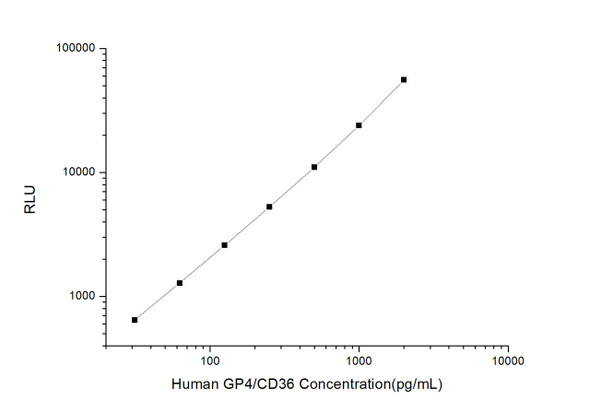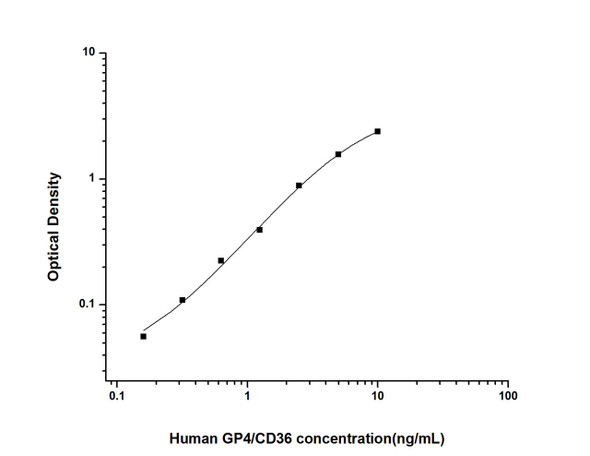Rat Signaling ELISA Kits 3
Rat GP4/CD36 (Platelet Membrane Glycoprotein IV) CLIA Kit (RTES00567)
- SKU:
- RTES00567
- Product Type:
- ELISA Kit
- ELISA Type:
- CLIA Kit
- Size:
- 96 Assays
- Sensitivity:
- 37.5pg/mL
- Range:
- 62.5-4000pg/mL
- ELISA Type:
- Sandwich
- Synonyms:
- GPIV, FAT, GP3B, GP88, PASIV, SCARB3, BDPLT10, CHDS7, gpIIIb, CD36 Molecule(Thrombospondin Receptor)
- Reactivity:
- Rat
- Sample Type:
- Serum, plasma and other biological fluids
- Research Area:
- Cell Biology
Description
| Assay type: | Sandwich |
| Format: | 96T |
| Assay time: | 4.5h |
| Reactivity: | Rat |
| Detection method: | Chemiluminescence |
| Detection range: | 62.50-4000 pg/mL |
| Sensitivity: | 37.50 pg/mL |
| Sample volume: | 100µL |
| Sample type: | Serum, plasma and other biological fluids |
| Repeatability: | CV < 15% |
| Specificity: | This kit recognizes Rat GP4/CD36 in samples. No significant cross-reactivity or interference between Rat GP4/CD36 and analogues was observed. |
This kit uses Sandwich-CLIA as the method. The micro CLIA plate provided in this kit has been pre-coated with an antibody specific to Rat GP4/CD36. Standards or samples are added to the appropriate micro CLIA plate wells and combined with the specific antibody. Then a biotinylated detection antibody specific for Rat GP4/CD36 and Avidin-Horseradish Peroxidase (HRP) conjugate are added to each micro plate well successively and incubated. Free components are washed away. The substrate solution is added to each well. Only those wells that contain Rat GP4/CD36, biotinylated detection antibody and Avidin-HRP conjugate will appear fluorescence. The Relative light unit (RLU) value is measured spectrophotometrically by the Chemiluminescence immunoassay analyzer. The RLU value is positively associated with the concentration of Rat GP4/CD36. The concentration of Rat GP4/CD36 in the samples can be calculated by comparing the RLU of the samples to the standard curve.
| UniProt Protein Function: | CD36: Binds to collagen, thrombospondin, anionic phospholipids and oxidized low-density lipoprotein (oxLDL). May function as a cell adhesion molecule. Directly mediates cytoadherence of Plasmodium falciparum parasitized erythrocytes. Binds long chain fatty acids and may function in the transport and/or as a regulator of fatty acid transport (By similarity). Receptor for thombospondins, THBS1 AND THBS2, mediating their antiangiogenic effects (By similarity). As a coreceptor for TLR4-TLR6, promotes inflammation in monocytes/macrophages. Upon ligand binding, such as oxLDL or amyloid-beta 42 binding, rapidly induces the formation of a heterodimer of TLR4 and TLR6, which is internalized and triggers inflammatory signals, leading to the NF-kappa-B-dependent production of CXCL1, CXCL2 and CCL9 cytokines, via MYD88 signaling pathway, and CCL5 cytokine, via TICAM1 signaling pathway, as well as IL1B secretion |
| UniProt Protein Details: | Protein type:Cell adhesion; Membrane protein, integral; Membrane protein, multi-pass Chromosomal Location of Human Ortholog: 4q11 Cellular Component: apical part of cell; apical plasma membrane; brush border membrane; caveola; cell surface; endoplasmic reticulum; external side of plasma membrane; extracellular space; Golgi apparatus; integral component of membrane; intracellular; intracellular membrane-bound organelle; membrane; membrane raft; mitochondrion; plasma membrane; protein complex; receptor complex; sarcolemma Molecular Function:high-density lipoprotein particle binding; lipid binding; low-density lipoprotein particle binding; low-density lipoprotein receptor activity; protein binding; transforming growth factor beta binding Biological Process: apoptotic cell clearance; cell surface receptor signaling pathway; cellular response to insulin stimulus; cGMP-mediated signaling; cholesterol transport; defense response to Gram-positive bacterium; eating behavior; elevation of cytosolic calcium ion concentration; fatty acid metabolic process; fatty acid oxidation; fatty acid transport; glucose homeostasis; gut development; immune response; interleukin-1 beta secretion; intestinal absorption; intestinal cholesterol absorption; lipid storage; lipoprotein transport; long-chain fatty acid metabolic process; long-chain fatty acid transport; low density lipoprotein mediated signaling; maternal placenta development; negative regulation of angiogenesis; negative regulation of systemic arterial blood pressure; negative regulation of transcription factor import into nucleus; negative regulation of transcription from RNA polymerase II promoter; nitric oxide mediated signal transduction; phagocytosis, recognition; positive regulation of blood coagulation; positive regulation of cell-matrix adhesion; positive regulation of cytokine secretion; positive regulation of I-kappaB kinase/NF-kappaB signaling; positive regulation of interleukin-12 production; positive regulation of interleukin-6 production; positive regulation of MAPK cascade; positive regulation of NF-kappaB transcription factor activity; positive regulation of nitric oxide biosynthetic process; positive regulation of peptidyl-tyrosine phosphorylation; positive regulation of phagocytosis; positive regulation of phagocytosis, engulfment; positive regulation of tumor necrosis factor production; receptor internalization; regulation of protein heterodimerization activity; regulation of toll-like receptor signaling pathway; response to activity; response to drug; response to estradiol; response to lipid; response to mechanical stimulus; response to nutrient; sensory perception of taste; triacylglycerol metabolic process; triglyceride transport |
| NCBI Summary: | fatty acid translocase; involved in long-chain fatty acid (LCFA) transport; important in fatty acid metabolism and insulin function [RGD, Feb 2006] |
| UniProt Code: | Q07969 |
| NCBI GenInfo Identifier: | 146345388 |
| NCBI Gene ID: | 29184 |
| NCBI Accession: | Q07969. 3 |
| UniProt Secondary Accession: | Q07969,Q925W0, |
| UniProt Related Accession: | Q07969 |
| Molecular Weight: | 52,731 Da |
| NCBI Full Name: | Platelet glycoprotein 4 |
| NCBI Synonym Full Names: | CD36 molecule |
| NCBI Official Symbol: | Cd36 |
| NCBI Official Synonym Symbols: | Fat; RGD1562323 |
| NCBI Protein Information: | platelet glycoprotein 4 |
| UniProt Protein Name: | Platelet glycoprotein 4 |
| UniProt Synonym Protein Names: | Adipocyte membrane protein; Fatty acid translocase; Fatty acid transport protein; Glycoprotein IIIb; GPIIIB; PAS IV; PAS-4; Platelet glycoprotein IV; GPIV; CD_antigen: CD36 |
| Protein Family: | Glycoprotein |
| UniProt Gene Name: | Cd36 |
As the RLU values of the standard curve may vary according to the conditions of the actual assay performance (e. g. operator, pipetting technique, washing technique or temperature effects), the operator should establish a standard curve for each test. Typical standard curve and data is provided below for reference only.
| Concentration (pg/mL) | RLU | Average | Corrected |
| 4000 | 54168 63994 | 59081 | 59046 |
| 2000 | 25752 29966 | 27859 | 27824 |
| 1000 | 13558 13410 | 13484 | 13449 |
| 500 | 6473 6737 | 6605 | 6570 |
| 250 | 3496 2990 | 3243 | 3208 |
| 125 | 1657 1505 | 1581 | 1546 |
| 62.50 | 703 807 | 755 | 720 |
| 0 | 33 37 | 35 | -- |
Precision
Intra-assay Precision (Precision within an assay): 3 samples with low, mid range and high level Rat GP4/CD36 were tested 20 times on one plate, respectively.
Inter-assay Precision (Precision between assays): 3 samples with low, mid range and high level Rat GP4/CD36 were tested on 3 different plates, 20 replicates in each plate.
| Intra-assay Precision | Inter-assay Precision | |||||
| Sample | 1 | 2 | 3 | 1 | 2 | 3 |
| n | 20 | 20 | 20 | 20 | 20 | 20 |
| Mean (pg/mL) | 211.27 | 539.24 | 1892.86 | 226.02 | 525.19 | 2064.03 |
| Standard deviation | 25.94 | 46.37 | 127.20 | 22.53 | 42.12 | 159.14 |
| C V (%) | 12.28 | 8.60 | 6.72 | 9.97 | 8.02 | 7.71 |
Recovery
The recovery of Rat GP4/CD36 spiked at three different levels in samples throughout the range of the assay was evaluated in various matrices.
| Sample Type | Range (%) | Average Recovery (%) |
| Serum (n=5) | 84-98 | 91 |
| EDTA plasma (n=5) | 86-97 | 92 |
| Cell culture media (n=5) | 98-111 | 105 |
Linearity
Samples were spiked with high concentrations of Rat GP4/CD36 and diluted with Reference Standard & Sample Diluent to produce samples with values within the range of the assay.
| Serum (n=5) | EDTA plasma (n=5) | Cell culture media (n=5) | ||
| 1:2 | Range (%) | 100-115 | 91-104 | 90-105 |
| Average (%) | 107 | 96 | 96 | |
| 1:4 | Range (%) | 87-102 | 103-117 | 96-111 |
| Average (%) | 94 | 108 | 103 | |
| 1:8 | Range (%) | 97-111 | 97-114 | 103-116 |
| Average (%) | 105 | 104 | 109 | |
| 1:16 | Range (%) | 96-114 | 92-108 | 94-109 |
| Average (%) | 104 | 99 | 100 |
An unopened kit can be stored at 4°C for 1 month. If the kit is not used within 1 month, store the items separately according to the following conditions once the kit is received.
| Item | Specifications | Storage |
| Micro CLIA Plate(Dismountable) | 8 wells ×12 strips | -20°C, 6 months |
| Reference Standard | 2 vials | |
| Concentrated Biotinylated Detection Ab (100×) | 1 vial, 120 µL | |
| Concentrated HRP Conjugate (100×) | 1 vial, 120 µL | -20°C(shading light), 6 months |
| Reference Standard & Sample Diluent | 1 vial, 20 mL | 4°C, 6 months |
| Biotinylated Detection Ab Diluent | 1 vial, 14 mL | |
| HRP Conjugate Diluent | 1 vial, 14 mL | |
| Concentrated Wash Buffer (25×) | 1 vial, 30 mL | |
| Substrate Reagent A | 1 vial, 5 mL | 4°C (shading light) |
| Substrate Reagent B | 1 vial, 5 mL | 4°C (shading light) |
| Plate Sealer | 5 pieces | |
| Product Description | 1 copy | |
| Certificate of Analysis | 1 copy |
- Set standard, test sample and control (zero) wells on the pre-coated plate and record theirpositions. It is recommended to measure each standard and sample in duplicate. Note: addall solutions to the bottom of the plate wells while avoiding contact with the well walls. Ensuresolutions do not foam when adding to the wells.
- Aliquot 100µl of standard solutions into the standard wells.
- Add 100µl of Sample / Standard dilution buffer into the control (zero) well.
- Add 100µl of properly diluted sample (serum, plasma, tissue homogenates and otherbiological fluids. ) into test sample wells.
- Cover the plate with the sealer provided in the kit and incubate for 90 min at 37°C.
- Aspirate the liquid from each well, do not wash. Immediately add 100µL of BiotinylatedDetection Ab working solution to each well. Cover the plate with a plate seal and gently mix. Incubate for 1 hour at 37°C.
- Aspirate or decant the solution from the plate and add 350µL of wash buffer to each welland incubate for 1-2 minutes at room temperature. Aspirate the solution from each well andclap the plate on absorbent filter paper to dry. Repeat this process 3 times. Note: a microplatewasher can be used in this step and other wash steps.
- Add 100µL of HRP Conjugate working solution to each well. Cover with a plate seal andincubate for 30 min at 37°C.
- Aspirate or decant the solution from each well. Repeat the wash process for five times asconducted in step 7.
- Add 100µL of Substrate mixture solution to each well. Cover with a new plate seal andincubate for no more than 5 min at 37°C. Protect the plate from light.
- Determine the RLU value of each well immediately.






